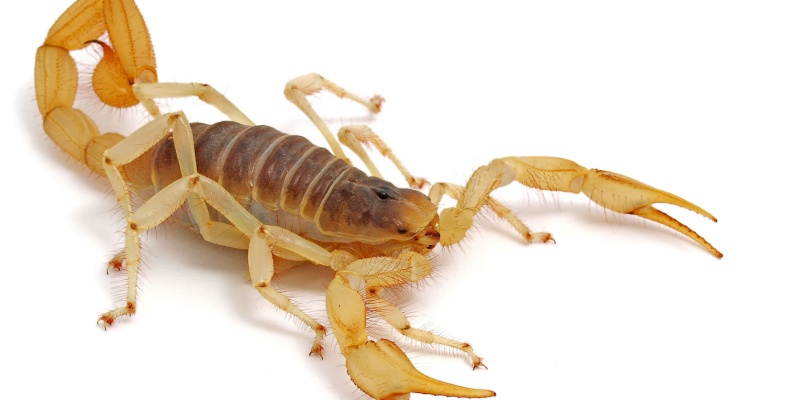Las Vegas residents know all too well that sharing our desert environment means occasionally encountering scorpions. While most people recognize a scorpion when they see one, being able to identify specific species can be valuable for understanding the risks they pose and determining the most effective control strategies. At Pest Raiders, we've encountered every scorpion species in the Las Vegas Valley, and we're sharing our expertise to help you identify the most common ones you might encounter.
Bark Scorpion (Centruroides sculpturatus)
Appearance
- Size: 2-3 inches in length
- Color: Light brown to yellowish, sometimes with faint stripes
- Distinctive Features: Slender body and tail, thin pincers (pedipalps), often holds its tail to the side rather than curled over its back
Habitat and Behavior
Bark scorpions are excellent climbers and can scale vertical surfaces including stucco, brick, and tree bark—a unique ability among scorpions in our region. This climbing capability allows them to access homes through trees touching rooflines, overhead power lines, or by scaling exterior walls directly.
In Las Vegas homes, bark scorpions commonly hide in:
- Wall voids and attics
- Folded towels and bedding
- Shoes and clothing
- Behind loose baseboards
- Inside electronic devices
Risk Level: High
The bark scorpion delivers the most painful sting of any scorpion in the United States. While rarely life-threatening to healthy adults, their venom can cause severe pain, numbness, tingling, and in some cases, difficulty breathing. Their stings pose particular risks to children, elderly individuals, and those with compromised immune systems.
Desert Hairy Scorpion (Hadrurus arizonensis)
Appearance
- Size: The largest scorpion in North America, reaching 5-7 inches in length
- Color: Yellow-brown to olive green with a darker back
- Distinctive Features: Robust body, hairy appearance (especially on the tail), large pincers
Habitat and Behavior
Desert hairy scorpions typically create burrows up to 8 feet deep in the soil. Unlike bark scorpions, they are poor climbers but excellent diggers. They prefer undisturbed areas with loose soil around home foundations, rock landscaping, and desert landscaped yards.
In Las Vegas properties, they're commonly found:
- Under landscape rocks and pavers
- In garden beds with loose soil
- Near pool equipment pads
- In irrigation valve boxes
- Around foundation perimeters
Risk Level: Moderate
Although intimidating due to their size, desert hairy scorpions deliver a less potent sting than bark scorpions. Their sting is described as similar to a bee sting—painful but generally not requiring medical attention unless allergic reactions occur.
Stripe-Tailed Scorpion (Hoffmannius spinigerus)
Appearance
- Size: Medium-sized, typically 2-3 inches long
- Color: Tan to dark brown with distinctive dark stripes running lengthwise on its tail
- Distinctive Features: Striped tail (as the name suggests), relatively thick body compared to bark scorpions
Habitat and Behavior
These scorpions are ground-dwellers that prefer to hide under objects rather than creating deep burrows. They're often found under rocks, wood piles, and yard debris around Las Vegas homes.
Common hiding places include:
- Under decorative rocks in xeriscaping
- Beneath pool toys and equipment
- In cinder blocks and retaining walls
- Under garden pots and planters
- Inside concrete expansion joints
Risk Level: Low to Moderate
The sting of a stripe-tailed scorpion typically causes localized pain, swelling, and occasional numbness. Most healthy adults experience discomfort lasting several hours without serious complications.
Yellow Ground Scorpion (Vaejovis confusus)
Appearance
- Size: Smaller species, usually 1-2 inches in length
- Color: Pale yellow to light tan
- Distinctive Features: More robust pincers relative to its body size, shorter tail than bark scorpions
Habitat and Behavior
As their name suggests, yellow ground scorpions stay close to the ground and rarely climb. They create shallow burrows under rocks and debris and are most common in established Las Vegas neighborhoods with mature landscaping.
Typical hiding spots include:
- Under landscape stones and pavers
- Beneath wood chips and mulch
- In garden beds and compost piles
- Around irrigation systems
- In cracks in the soil and concrete
Risk Level: Low
Yellow ground scorpions deliver relatively mild stings, typically causing localized pain and slight swelling. Most reactions resolve without medical intervention within a few hours.
Identifying Scorpions Safely
If you need to identify a scorpion in your Las Vegas home:
- Never handle scorpions with bare hands
- Use tongs or a container if removal is necessary
- Inspect using a UV blacklight at night—all scorpions glow blue-green under ultraviolet light
- Take a photo from a safe distance for identification by professionals
What to Do If You Find Scorpions in Your Las Vegas Home
Finding even one scorpion indoors often indicates conditions favorable for others. The presence of bark scorpions is particularly concerning due to their potent venom and tendency to enter homes.
At Pest Raiders, we specialize in identifying and controlling all scorpion species found in Las Vegas. Our comprehensive approach includes:
- Species identification to target control measures appropriately
- Thorough inspection of your property's interior and exterior
- Customized treatment plans based on the specific species and your home's vulnerabilities
- Ongoing monitoring and prevention strategies
Don't risk painful encounters with the scorpions sharing our Las Vegas desert. Contact Pest Raiders today for expert scorpion identification and effective, long-lasting control solutions designed specifically for your property.
